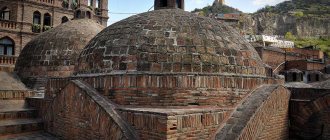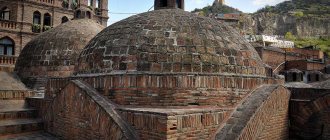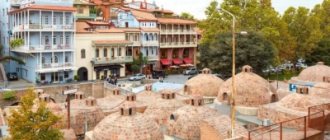Every country has something unique and Georgia is no exception. In addition to stunning natural and urban landscapes, as well as a large number of historical monuments, there are the sulfur baths of Tbilisi - a special place, famous far beyond the borders of Georgia. One of the main attractions for travelers, where Georgians themselves like to relax.
What is Abanotubani
The sulfur baths in Tbilisi are a famous and unique landmark of Georgia. This is a complex of baths called Abanotubani, built on natural sulfur springs in the 16th-19th centuries.
Sulfur baths of Abanotubani
The name Abanotubani itself comes from the merger of the Georgian words abano (i.e. bathhouse) and ubani (district). That is, literally this is the bathhouse area.
Today there are about a dozen sulfur baths in Old Tbilisi. Together they make up an entire city block. The exact time of appearance of each bath is not known, but the oldest is considered to be Iraklievskaya, known since the 16th century.
It is no coincidence that Tiflis was built on warm springs. They have always served as a swimming place for the local residents. In the Abanotubani area, archaeologists found baths of the 1st-2nd centuries, with changing rooms and mosaic pools. The city even got its name from the word tbili (or tefili), which means warm.
Sulfur baths Tbilisi:
- Motley Bath (Orbelianovskaya)
- Bathhouse No. 5
- Mirzoevsky baths (Tsarina bath + Fantasy bath)
- Bathhouse Gulo
- Royal Bath (Royal)
- Iraklievskaya bath
- VIP bathhouse (part of bathhouse No. 5)
All of these baths have traditional steam rooms (Finnish saunas and Turkish hammams), hot sulfur pools and pools filled with mineral water. Taking a dip in a cool spring after a steam room is a mandatory part of the program.
A holiday in Abanotubani will not be complete without a bathhouse attendant. For 20 GEL, they offer a classic foam peeling (about the same as in Turkish hamams). If desired, you can order any other massage: chocolate, sports, relaxing or perhaps wine.
“Iraklievskaya”, or “Bath of King Irakli”
The Iraklievskaya bathhouse, which is considered one of the oldest buildings in the complex, was originally called VIP. However, over time this was forgotten. And immediately after privatization, the building was renamed and also received a separate entrance. You can reach it by following the sign, on which it is simply called “Sulfur Bath”. It has four small rooms with different prices and focus: from 10 to 50 lari (300-1500 rubles).
Sulfur baths in Tbilisi: prices 2021
Separate VIP room in the Motley Bath
Which bathhouse in Tbilisi is worth going to depends on how you want to relax - in the common room or separately with your own group.
All Abanotubani sulfur baths are united by the presence of individual steam rooms designed for 1-6 people.
Only three baths - Orbelianovskaya, No. 5 and Mirzoevskaya - have public halls. At the same time, there are separate rooms for women and men.
It is worth noting that there is a swimming pool in the common room for women only in the Mirzoevskaya Bathhouse. In the rest, ladies will only be offered a shower.
Each sandpiper praises its swamp - this is the job.
What I really, really like here is that the Georgian people have formed their own attitude - the government of the country (any) is one thing, citizens are another. You should not base your point of view on the field of the “first” channel.
You need to understand that the main channels do the work, the propogondons must criticize someone else’s and praise their own. My personal experience is that I have never experienced neglect of my Russian language. And I don’t know a single case when a Georgian treated a guest in his country with disrespect.
History of Abanotubani
The sulfur baths of Tiflis are very ancient. The earliest baths, the remains of which have been found by archaeologists, date back to the 1st-2nd centuries. It’s mind-boggling, but even then they had ceramic water pipes, locker rooms and stone pools.
In Georgia, there is a legend about the founding of Tbilisi, connected with the history of Abanotubani. According to legend, in the 5th century AD, the then king Vakhtang Gorgasali hunted near the river. His hunting falcon captured a pheasant, and it fell into one of the hot springs and was boiled (according to another version, it was healed from its wound).
The king was delighted and ordered to build a bathhouse and a city around the source, and then completely moved the capital from Mtskheta to Tiflis.
The legend of the falcon and pheasant is immortalized in a monument in the center of the Abanotubani quarter:
Falcon with pheasant in the Abanotubani quarter
The bathhouse has grown into a whole complex. This is how the hydrogen sulfide baths of Abanotubani appeared.
In the 16th century, indoor baths with domes appeared. Their walls were decorated with rich mosaics according to the Persian fashion of that time.
Subsequently, they were destroyed and rebuilt more than once. Of the 60 working bathhouses, less than a dozen remain today.
In addition to their direct function, the baths served a public purpose. Like any medieval and ancient baths, Tiflis baths served as a place for communication, business meetings, relaxation and discussion of news.
Dariko
Autumn has reached Tbilisi - by the end of October, it’s probably time to lower the temperature to a frightening +12 or even +10, add some rain and fog... But what to do if you are a tourist, you only have a few days to do everything, and Do you really hate to sit in a hotel or apartment and watch the rain from the window? My usual recommendations in case of absence of various festivals and concerts: go to the Museum of the History of Georgia and the Blue Gallery (I myself love them very much), appreciate the gigantomania of Zurab Tsereteli at the Museum of Modern Art, go to a performance of the Rezo Gabriadze Puppet Theater, the Kakha Bakuradze Movement Theater or pantomime theater, look for the truth in wine cellars, in the end.
But one of the most correct, useful and authentic options in case of rain (as well as sadness, hangover, fatigue or lack of impressions) is a trip to a sulfur bath. Let me not quote Pushkin with his praise for the Tbilisi baths, however, I have never seen anything better. Probably because it is not recommended for me to go to a traditional bathhouse with hellish heat and steam for a number of reasons (I didn’t go), but it’s quite possible to go to ones like here.
The essence, salt and meaning of going there, in theory, lies in the healing hot sulfuric water, which is supplied to the pools directly from the springs. That is, there is literally no need to steam! You come, wash, cool off in the pool, and then, if desired, a mekise comes - a bathhouse attendant, a massage therapist, whatever you want to call it - kneads your stressed body and scrubs it clean with a hard washcloth, so that the skin becomes very soft and tender. Then the pool can be repeated several times - there is no need to stay too long, it is better to arrange several visits for 5-7 minutes.
However, there is another essence, salt and meaning - namely, communication. As they write on all tourist sites, the bathhouse used to be a place for discussing city gossip. I associate going to the bathhouse with an episode from the book “Ali and Nino” I read a couple of years ago: there, while visiting the Tbilisi relatives of his future wife, the Azerbaijani young man Ali overindulges in alcohol at a supra (feast), and the next morning his relatives take him to the bathhouse, where, after a powerful massage and wonderful stinking water, he is literally born again. In the meantime, Ali is cathartic in the hands of the bathhouse attendant, the rest of the men in the bathhouse are taking sulfur baths, discussing events in the city and even treating themselves to something. It was all described so colorfully that in 2013, during my second tourist visit to Tbilisi, I finally went to Abanotubani, the area of sulfur baths.
Since moving, I go there quite often. Of course, there are a couple of other places in the city where you can improve your health in sulfur water - I once wrote that a very cool new bathhouse was opened on Lake Lisi, and there were also several places on the left bank, near Agmashenebeli Avenue. However, I remain true to the heart of Tbilisi, and if there is no pleasant company for me to go to the bathhouse, then I do not shy away from the general women’s bath (however, I choose a time when there are not very many people there). Returning to the issue of conversations - yes, people come there and chat, many know each other. But since Tbilisi has grown significantly, gossip there arises only in the regional, Ortachala-Avlabari regions.
I recently had a group of tourists from Sweden who wanted to experience both a massage and the effects of sulfur water, all for a reasonable, non-tourist price. Then I realized that I had not done a more or less thorough study of the services offered in two years... As you understand, after such a long waltz around the bath topic with a washcloth at the ready, I am obliged to briefly and clearly tell you about decent places where you can try traditional Tbilisi spa. Go!
Bathhouse number 5
Locally famous along with Tsarskaya, it is located right next to the park named after Heydar Aliyev. There are always people there - in the general section or in separate rooms. A shared bathhouse (of course, men and women wash separately) costs 3 GEL/hour, towel rental costs 1 GEL/piece. The cheapest rooms at 20 GEL include only a shower - people actually go there to wash! Rooms with a sulfur pool cost 40 GEL, and for 80 and 100 you can use the sauna. Open from 8am to midnight. At the time when I came to “explore the market,” all the rooms were occupied, so it was not possible to photograph the interior.
Royal Bath / Samepo
Located on Grishashvili Street 1, to the left of the monument to the falcon and pheasant. I went to this bathhouse for the very first time. Not the cheapest, open from 8 am to 11 pm. The cost of rooms is from 65 to 95 GEL, the sauna is paid separately and costs 75 GEL.
"Bathhouse Gulo"
Grishashvili Street 3, in a dead end just above Tsarskaya. My favorite in terms of price-quality ratio. There are private rooms for 30, 40, 70, 100, 120 and 200 GEL per hour. The thirty-lar room will only fit two people, and there will be no sauna. My Swedes went to a room for 100 lari/hour, which had a sauna, a fairly spacious pool with sulfur water, and enough space for four people. More expensive rooms can accommodate up to 10 people, the pools are larger, and a sauna is also available. I liked the massage.
Renting clean towels will cost 2 GEL per piece, shampoo and soap - from 1.5 GEL. Tea and coffee are offered free of charge, so don’t miss the chance to spend time in a truly oriental way: bathhouse, massage, hot tea. Another plus is that the bathhouse is open for quite a long time: from 7 am to 3 am.
Fun fact: singer Sting once performed in Tbilisi, and the concert organizers included a trip to Gulo in his entertainment program. And Sting liked it there so much that the next day he came there again!
“Fantasy” (historically – Mirzoev bathhouse)
It is located in the next dead end after “Bakhmaro”, if you go up Grishashvili Street, next to the “Bohema” restaurant. Archaeologists conducted research here and claim that the bathhouse is at least 300 years old, and it is perhaps the first that appeared and, importantly, survived in the entire historical Abanotubani. Sulfur water enters the pools directly from the source.
“Fantasy” has the widest range of prices and many rooms of different sizes. Prices range between 30 and 100 GEL (as you understand, the difference is in capacity). The sauna costs 50 GEL. In addition, they offer a lot of different types of massage - Thai, Indian, acupressure, classic, relaxing. The cost of a session is from 20 to 30 GEL.
I was also in this bathhouse, and if we talk about the friendliness of the staff, then I am always very lucky with the managers. It was also very nice to sit in the pool and drink tea with nut jam served right there. I received a strong massage, just as I needed (thanks to Mekisa Zemfira!): my skin glowed for several days in a row. In a word, I spent my time there exactly as I imagined when I read “Ali and Nino”











